[ad_1]
The theme of Black History Month this year is “Black Health and Wellness.” While health and wellness encompass physical, mental and spiritual health, the focus of this blog is on mental health, which has long been a taboo subject in the Black community, even more so than in society at large. As a result, just one in three Black people who struggle with mental health issues receive appropriate treatment. Couple that with the fact that Black adults are 20% more likely to report serious psychological distress than white adults and a troubling scenario reveals itself.
There are many possible reasons why the Black community might experience a disproportionate number of mental health concerns, including the racial inequities seen in almost all sectors of society, including healthcare. In addition, the long history of dehumanization, oppression and violence against Black people has evolved into modern structural and institutional racism, which affects mental health in countless ways. In combination, this often manifests as a distrust of the government and large institutions, including the medical system. Also, socioeconomic disparities that are common in the Black community often limit access to health insurance and other vital health-related resources.
While society has become more cognizant of these issues, and increasingly willing to talk about them in a meaningful and productive way, we are still falling well short of the ultimate goal of equity for every individual in all segments of society.
The normalization of discussions of mental health, particularly in the Black community, is just one small piece of the complex topic of holistic health. Instead of focusing on the “mental health struggles” of the Black community, a more positive spin on this situation that health coaches and exercise professionals may want to adopt involves celebrating Black joy, which many experts and activists cite as a centerpiece of Black culture.
As a health coach or exercise professional, you can facilitate that joy by celebrating Black culture through not only a purposeful acceptance of all clients and participants, regardless of their skin color, but also through marketing and social media content that shows Black people feeling the joy and reaping the rewards of physical activity. The objective is to create a facility and a community of members who feel not only welcomed and empowered, but also respected and valued, regardless of their background.
Of course, it is not appropriate for health coaches and exercise professionals to diagnose mental health concerns. That said, the positive effects of physical activity on mental health are well documented, so it is certainly appropriate for you to emphasize these benefits when working with clients, particularly Black clients. When discussing programming and behavior change with clients, for example, consider highlighting the fact that physical activity has been proven to reduce symptoms of depression and anxiety. Encourage your clients to incorporate one or more of the following mindfulness techniques into their daily routines:
- Mindful movement: Most people think of yoga, tai chi or qigong when they think of mindful movement—and these are all fantastic options—but walking, running, cycling and rowing can also be mindful if distractions are removed, both internal and external, and focus is placed on the repetition of the movement, one’s breathing pattern and the way the body feels as it moves through space.
- Meditation: There are many types of meditation practice, but if someone is new to meditation or just want a way to relax during stressful times, keep it simple. Find or create a distraction-free zone and sit or lie down—whatever is most comfortable—for 10 or 15 minutes of quiet time or prayer. Try to disregard thoughts as they arise and instead focus on your breathing pattern and other physical cues. Another type of meditation involves contracting and relaxing the muscles, starting at the toes and moving through each muscle group until the muscles of your face and head are reached. Finally, there are countless phone apps and YouTube videos with guided meditation, which can be a great place to start.
- Breathing exercises: Breathing exercises are sometimes performed in combination with meditation, but they can also be performed on their own. As few as 10 mindful breaths can relax the mind and body and allow one to refocus. There are a number of techniques that can be explored, including diaphragmatic breathing and pursed-lip breathing, but here is a simple way to start: put one hand on the stomach and the other on the chest. Breathe slowly and be aware of how the air moves in and out of the body, inflating and deflating with each breath.
Normalizing this type of discussion, in a way that does not single out any individual or group, can be a powerful and important step toward explicitly drawing a connection between physical activity and mental health, resulting in improved overall well-being.
[ad_2]
Source link



